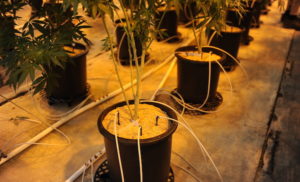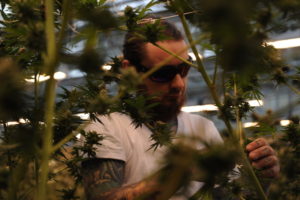
Retrofitting a Greenhouse for Hemp
When Connecticut-based Hydroclonix began transitioning an 80,000-square-foot greenhouse into a hemp cultivation facility, the company enlisted the experience of COO and lead cultivator Joe Conklin and the expertise of Griffin Greenhouse Supplies’ technical team to make its vision come true. A focus on micro-irrigation
and LED lighting has allowed Hydroclonix to grow a healthy hemp crop indoors
year-round. Conklin’s experience from his time in the medical cannabis industry has helped the company convert the greenhouse — formerly used to grow perennials and hydroponic lettuce — into a facility capable of harvests every two to three weeks. The harvested hemp is used for its Hemp House Farms line of hemp oils and flower, focusing on cannabinoids like CBD, CBG, and CBM.
“I’m really growing these plants how I did with [medical cannabis plants] and it’s making quite a bit of difference that we’ve noticed with yields, quality, and terpene production for aromas, as well as cannabinoids increasing,” says Conklin.

FINE-TUNING IRRIGATION
Having worked with Griffin previously, Conklin brought in GGSPro, Griffin’s technical support team, to collaborate on improving the greenhouse’s irrigation equipment for efficiency and durability.
“We’re not a perfectly dry indoor facility, so having equipment that could handle whatever the weather is throwing at us is pretty important for not having to replace equipment as often and just having heavier-duty items,” says Conklin.
Hydroclonix went from hand-mixture batches to full automation, Conklin says. Hunter watering systems were installed for drip-irrigation, or micro-irrigation as Griffin’s technical support specialists call it.
“The emitters are set up and designed, if installed correctly, that you can time to the minute the exact amount of water you’re putting down on a plant,” says Peter Armando, technical sales for Griffin’s CEA division, who worked with Conklin on the upgrade. “If you want to water your plant four ounces of water every four hours evenly across a greenhouse operation, it’s very easy to do with micro-irrigation today. In these types of crops, in which you have no tools to fix
root damage, we have to be really precise on our water skill — not to overwater or underwater the plant.”
Hydroclonix staggers its watering, with 360 plants being watered about every 20 minutes for three hours a day.
The ability to remotely monitor irrigation is not only labor and time saving, but also more in line with technology the next generation of growers is used to using, says Armando.
“Most of the world now, you get into the hemp and cannabis arena, the average age is 35. Their world lives off their phone that hangs on their side,” he says. “So we’ve been asked a lot now to want to be able to monitor irrigation and operate systems by looking on their phone. We’ve been lucky enough that a lot of your controllers of today are developed for the lawn and grass industry that go through the cloud-based system to where we can design inexpensive drip irrigation that’s triggered off your phone.”

TRANSITIONING TO LEDS
Hemp only flowers under a light schedule of 12 hours on and 12 hours off, explains Conklin. Precise control over lighting, whether natural or not, is critical for achieving the right light intensity at the right times. Hydroclonix is in the process of switching all lighting in the greenhouse from HPS bulbs to Philips LEDs.
“I probably wouldn’t have said that or done that maybe three or four years ago but the [LED] technology has increased a lot,” says Conklin. “The full spectrum they’re able to put out is unmatchable by any other single-source spectrum.”
Controllers will measure the sun’s PAR (photosynthetic active radiation) to turn off the lights when they’re unneeded and have them on when they are. Lights will even be dimmed according to how much PAR the sun is putting out at any given time, says Conklin.
Lighting can be a huge expense for growers but the considerations should go beyond price point, says GGSPro technical support specialist George Grant. In particular, Grant recommends analyzing the effects lighting will have on other systems such as ventilation.
“[LEDs and HPS] give out energy in the form of light but they also give out energy in the form of heat. A major negative compared to LED is HPS provides a lot of external heat,” says Grant. “An indoor environment with HPS would be a
much hotter environment so we have to put a lot more energy, thus costs, into our AC units to counteract that heat. Whereas with LEDs, they don’t give off nearly as much heat and thus we’re saving money on the backend by not having to increase our AC units.”
Armando credits the hemp and cannabis industries with making LED lighting a more appealing investment.
“Thanks to the hemp and cannabis arena, our normal hort customers now have gravitated greatly to LED lighting, both in vertical rack systems to do cuttings and early plug stages and even to time out flowering of crops,” he says. “So lighting has taken an explosion across the industry.”
Next for Hydroclonix is becoming fully vertically integrated, with plans for its own extraction facility down the line.
“We do want to just keep expanding our product line and staying on top of whatever the hot topics of the industry are at the time,” Conklin says. “We’re constantly bringing in new genetics and making sure that we have the best that’s out there and what is currently in demand that’s producing the highest cannabinoid and terpene profiles.”



